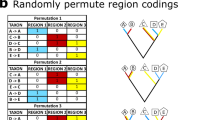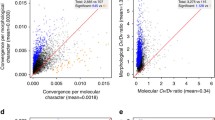Abstract
The monophyly of Rodentia has repeatedly been challenged based on several studies of molecular sequence data. Most recently, D'Erchia et al. (1996) analyzed complete mtDNA sequences of 16 mammals and concluded that rodents are not monophyletic. We have reanalyzed these data using maximum-likelihood methods. We use two methods to test for significance of differences among alternative topologies and show that (1) models that incorporate variation in evolutionary rates across sites fit the data dramatically better than models used in the original analyses, (2) the mtDNA data fail to refute rodent monophyly, and (3) the original interpretation of strong support for nonmonophyly results from systematic error associated with an oversimplified model of sequence evolution. These analyses illustrate the importance of incorporating recent theoretical advances into molecular phylogenetic analyses, especially when results of these analyses conflict with classical hypotheses of relationships.
Similar content being viewed by others
LITERATURE CITED
Adachi, J., and Hasegawa, M. (1996) MOLPHY version 2.3: Programs for molecular phylogenetics based on maximum likelihood. Computer Science Monographs, No. 28, Institute of Statistical Mathematics, Tokyo.
Cao, Y., Adachi, J., Yano, T., and Hasegawa, M. (1994). Phylogenetic place of guinea pigs: No support of the rodent-polyphyly hypothesis from maximum-likelihood analyses of multiple protein sequences. Mol. Biol. Evol. 11: 593–604.
Cao, Y., Okada, N., and Hasegawa, H. (1997). Phylogenetic position of guinea pigs revisited. Mol. Biol. Evol. 14: 461–464.
D'Erchia, A. M., Gissi, C., Pesole, G., Saccone, C. and Arnason, U. (1996). The guinea-pig is not a rodent. Nature 381: 597–600.
Felsenstein, J. (1978). Cases in which parsimony and compatibility methods will be positively misleading. Syst. Zool. 27: 401–410.
Gaut, B. S., and Lewis, P. O. (1995). Success of maximum likelihood phylogeny inference in the four-taxon case. Mol. Biol. Evol. 12: 152–162.
Goldman, N. (1993). Statistical tests of models of DNA substitution. J. Mol. Evol. 36: 182–198.
Graur, D., Hide, W. A., and Li, W.-H. (1991). Is the guinea-pig a rodent? Nature 315: 649–652.
Gu, X., Fu, Y.-X., and Li, W.-H. (1995). Maximum likelihood estimation of the heterogeneity of substitution rate among nucleotide sites. Mol. Biol. Evol. 12: 546–557.
Hasegawa, M., Kishino, H., and Yano, T. (1985). Dating the human-ape split by a molecular clock of mitochondrial DNA. J. Mol. Evol. 22: 160–174.
Hasegawa, M., Cao, Y., and Adachi, J. (1992). Rodent polyphyly? Nature 255: 595.
Hendy, M. D., and Penny, D. (1989). A framework for the quantitative study of evolutionary trees. Syst. Zool. 20: 406–416.
Huelsenbeck, J. P. (1995). Performance of phylogenetic methods in simulation. Syst. Biol. 44: 17–48.
Huelsenbeck, J. P., Hillis, D. M., and Jones, R. (1996). Parametric bootstrapping in molecular phylogenetics: Applications and performance. In: Molecular Zoology: Advances, Strategies, and Protocols, J. D. Ferraris and S. R. Palumbi, eds. pp. 19–45, Wiley-Liss, New York.
Janke, A, Xu, X., and Arnason, U. (1996). The complete mitochondrial genome of the wallaroo (Macropus robustus) and the phylogenetic relationship among Monotremata, Marsupalia, and Eutheria. Proc. Natl. Acad. Sci. USA 94: 1276–1281.
Jukes, T. H., and Cantor, C. R. (1969). Evolution of protein molecules. In: Mammalian Protein Metabolism, H. N. Munro, ed., pp. 21–132. Academic Press, New York.
Kimura, M. (1980). A simple method for estimating evolutionary rate of base substitutions through comparative studies of nucleotide sequences. J. Mol. Evol. 16: 111–120.
Kishino, H., and Hasegawa, M. (1989). Evaluation of the maximum likelihood estimate of the evolutionary tree topologies from DNA sequence data, and the branching order of Hominoidea. J. Mol. Evol. 29: 170–179.
Li, W.-H., Hide, W. A., Zharkikh, A., Ma, D.-P., and Graur, D. (1992). The molecular taxonomy and evolution of the guinea pig. J. Hered. 83: 174–181.
Luckett, W. P., and Hartenberger, J.-L. (1993). Monophyly or polyphyly of the order Rodentia: Possible conflict between morphological and molecular interpretations. J. Mammal. Evol. 2: 127–147.
Ma, D.-P., Zharkikh, A., Graur, D., VandeBerg, J. L., and Li, W.-H. (1993) Structure and evolution of opossum, guinea pig, and porcupine cytochrome b genes. J. Mol. Evol. 36: 327–334.
Maddison, W. P., and Maddison, D. R. (1992). MacClade—Analysis of Phylogeny and Character Evolution, Version 3.5, Sinauer, Sunderland.
Martignetti, J. A., and Brosius, J. (1993). Neural BC1 RNA as an evolutionary marker: Guinea pig remains a rodent. Proc. Natl. Acad. Sci. USA 90: 9698–9702.
McKenna, M. C. (1975). Toward a phylogenetic classification of the Mammalia. In: Phylogeny of the Primates: An Interdisciplinary Approach, W. P. Luckett and F. S. Szalay, eds. pp. 21–46, Plenum Press, New York.
Nedbal, M. A., Honeycutt, R. L., and Schlitter, D. A. (1996). Higher-level systematics of rodents (Mammalia, Rodentia): Evidence from the mitochondrial 12S rRNA gene. J. Mammal. Evol. 3: 201–237.
Novacek, M. J. (1990). Morphology, paleontology, and the higher clades of mammals. In: Current Mammalogy, H. H. Genoways, ed., pp. 507–543, Plenum Press, New York.
Porter, C. A., Goodman, M., and Stanhope, M. J. (1996). Evidence on mammalian phylogeny from sequences of exon 28 of the von Willebrand factor gene. Mol. Phyl. Evol. 5: 89–101.
Stanhope, M. J., Czelusniak, J., Si, J.-S., Nickerson, J., and Goodman, M. (1992). A molecular perspective on mammalian evolution from the gene encoding interophotoreceptor retinoid binding protein, with convincing evidence for bat monophyly. Mol. Phyl. Evol. 1: 148–160.
Sullivan, J., Holsinger, K. E., and Simon, C. (1995). Among-site rate variation and phylogenetic analysis of 12S rRNA data in sigmodontine rodents. Mol. Biol. Evol. 12: 988–1001.
Swofford, D. L., Olsen, G. P., Waddell, P. J., and Hillis, D. M. (1996). Phylogenetic inference. In: Molecular Systematics, 2nd ed., D. M. Hillis, C. Moritz, and B. K. Mable, eds., pp. 407–514, Sinauer, Sunderland, MA.
Waddell, P. (1995). Statistical Methods of Phylogenetic Analysis, Including Hadamard Conjugations, LogDet Transforms, and Maximum Likelihood, Ph.D. dissertation, Massey University, Palmerston North, New Zealand.
Waddell, P. J., and Penny, D. (1996). Evolutionary trees of apes and humans from DNA sequences. In: Handbook of Symbolic Evolution, A. J. Lock and C. R. Peters, eds., pp. 53–73, Clarendon Press, Oxford.
Yang, Z. (1994a). Estimating the pattern of nucleotide substitution. J. Mol. Evol. 39: 105–111.
Yang, Z. (1994b). Maximum likelihood phylogenetic estimation from DNA sequences with variable rates over sites: approximate methods. J. Mol. Evol. 39: 306–314.
Yang, Z. (1996). Phylogenetic analysis using parsimony and likelihood methods. J. Mol. Evol. 42: 294–307.
Yang, Z., Goldman, N., and Friday, A. E. (1994). Comparison of models for nucleotide substitution used in maximum-likelihood phylogenetic estimation. Mol. Biol. Evol. 11: 316–324.
Yang, Z., Goldman, N., and Friday, A. E. (1995). Maximum likelihood trees from DNA sequences: A peculiar statistical estimation problem. Syst. Biol. 44: 384–399.
Author information
Authors and Affiliations
Rights and permissions
About this article
Cite this article
Sullivan, J., Swofford, D.L. Are Guinea Pigs Rodents? The Importance of Adequate Models in Molecular Phylogenetics. Journal of Mammalian Evolution 4, 77–86 (1997). https://doi.org/10.1023/A:1027314112438
Issue Date:
DOI: https://doi.org/10.1023/A:1027314112438




